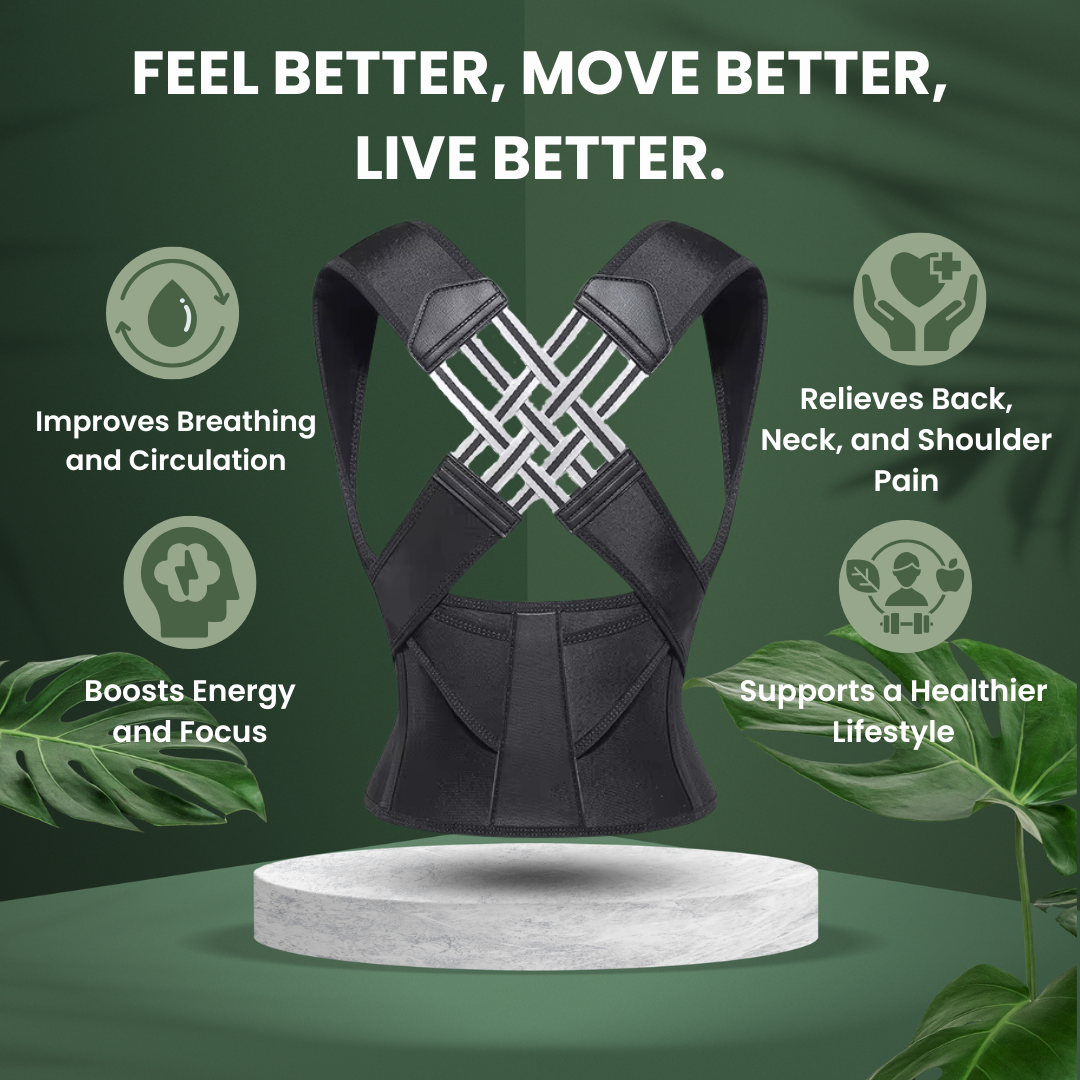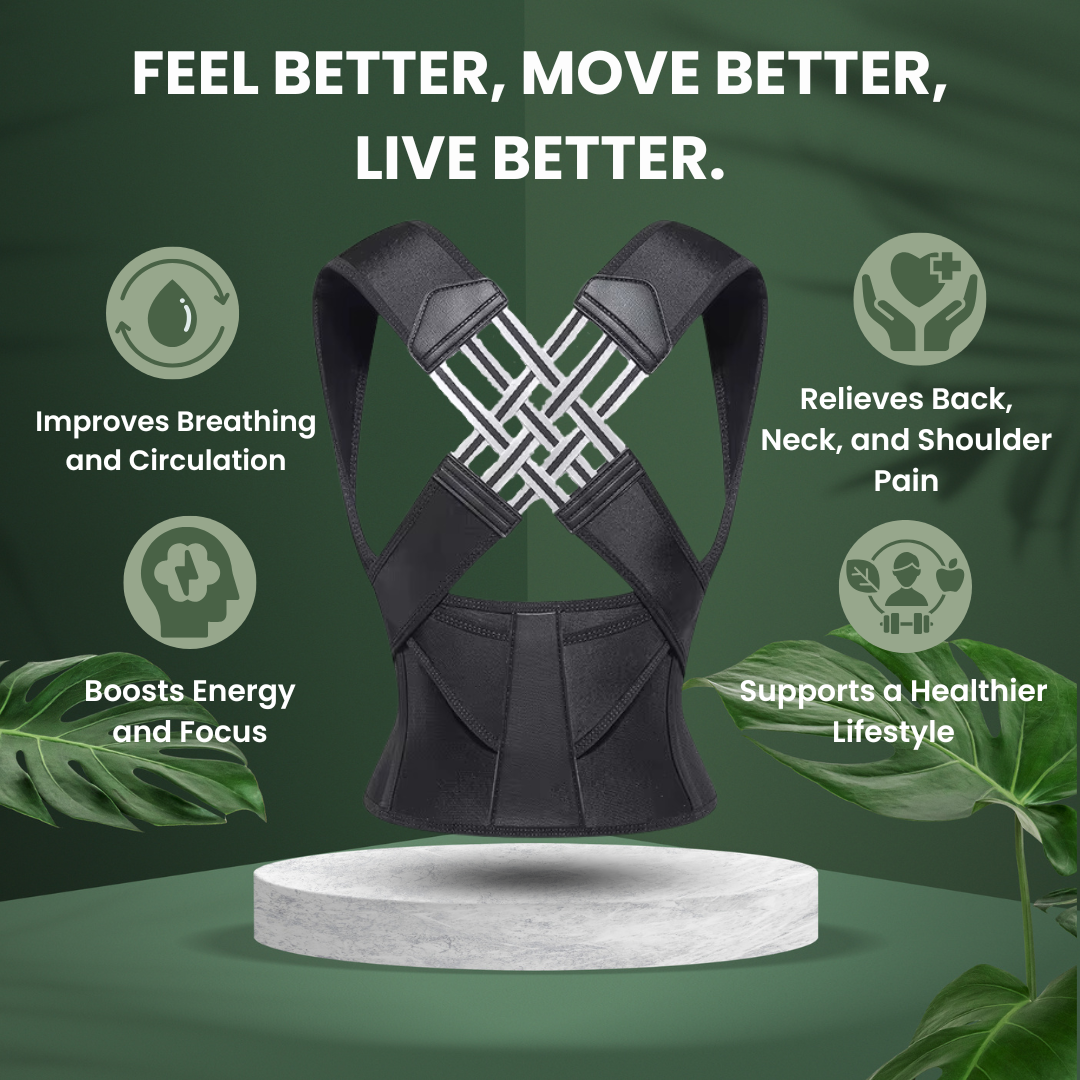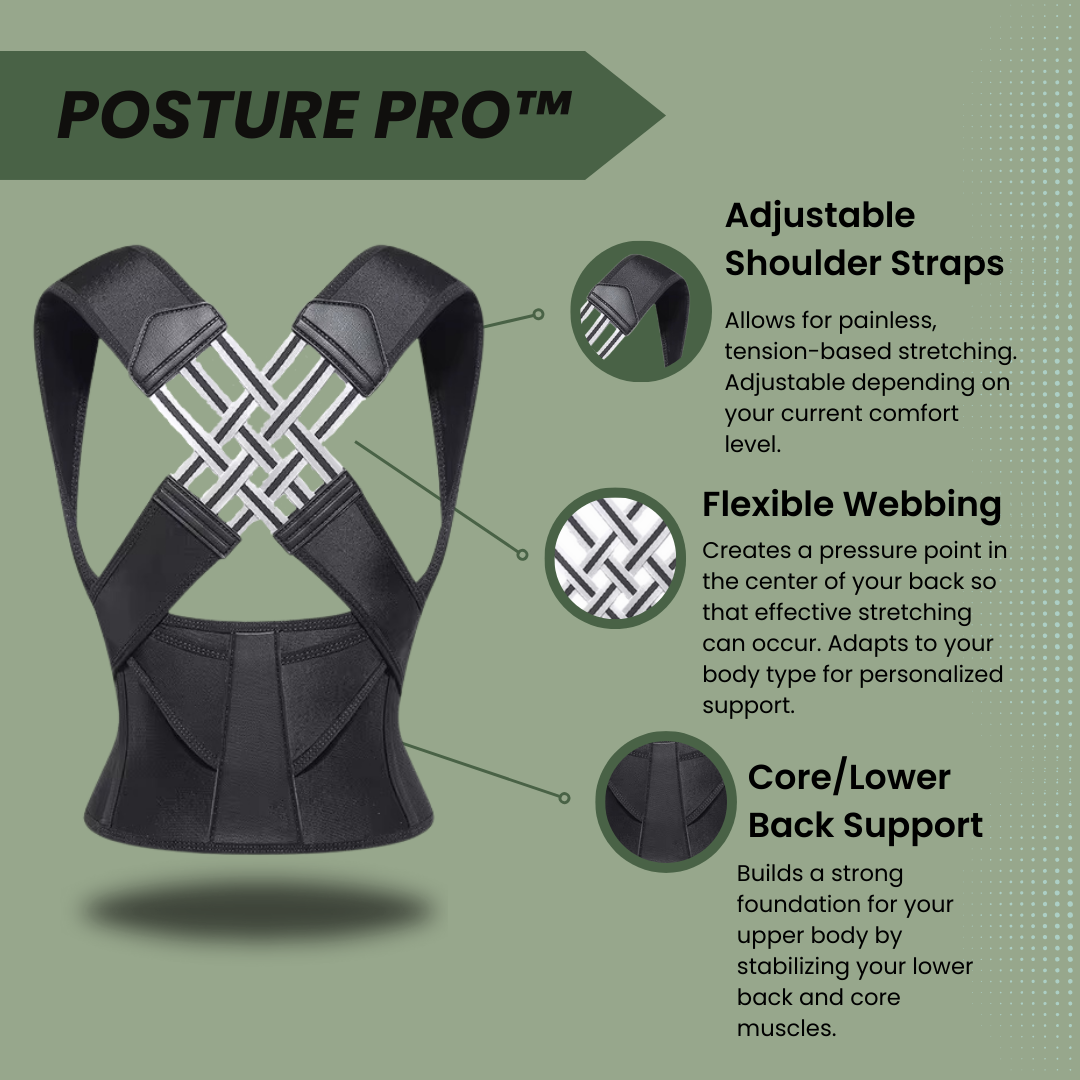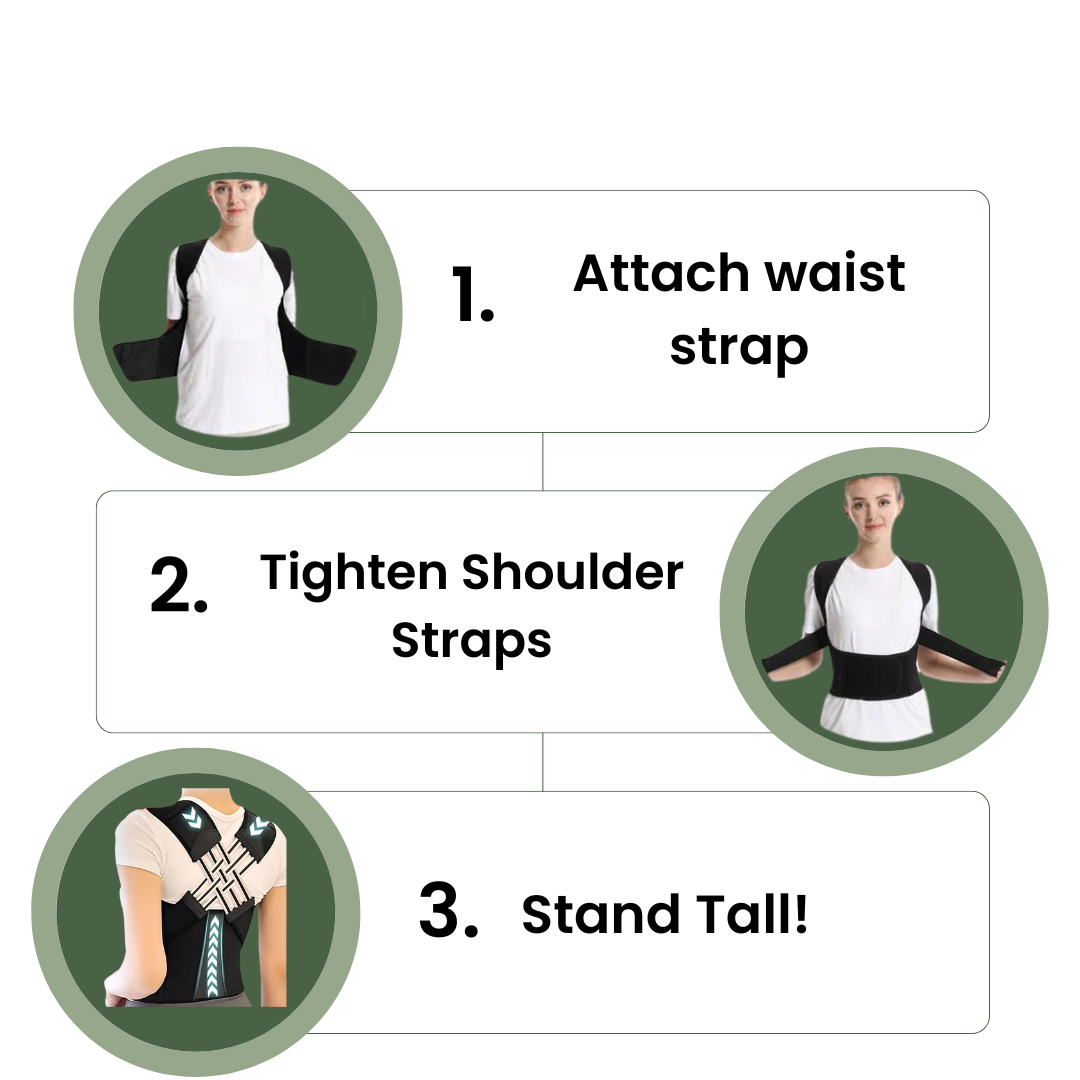Many people wonder why they feel aches in their backs. Good posture can prevent these common pains. This blog will show you what good posture is and how it impacts health. Learn more inside!
Key Takeaways
- Good posture ensures proper body alignment, supporting the spine and reducing risks of aches, pains, and injuries. It balances weight over feet for better stability.
- Poor posture can lead to back pain, weakened core muscles, difficulty breathing, neck issues, and negatively affect mood and energy levels.
- Practicing good posture habits throughout the day is essential. Use reminders or checklists for correct sitting, standing, and technology use positions.
- Strengthening core muscles through specific exercises improves posture by providing better support to the spine and facilitating easier movement.
- Seeking professional advice on posture can offer personalized strategies for improvement. Online resources also provide valuable information on maintaining proper alignment for long-term health benefits.
Definition of Posture
Posture refers to how we hold our bodies in different positions. Good posture reflects proper body alignment, which supports our spine and overall health.
The natural way of holding our body
Good posture is the natural way of holding our body. It involves correct body alignment, which supports our spine and helps prevent common aches and pains. Proper positioning allows us to balance and center our weight over our feet.
This alignment reduces stress on any single structure in our bodies, preventing overstressing. Good posture also promotes spinal support, which is vital for a healthy back.
“Proper posture can improve breathing and digestion.” Maintaining good posture enhances physical appearance and boosts confidence. Active engagement of core muscles contributes to better overall health by stabilizing the body during movement.
Understanding what good posture entails is essential for long-term well-being and injury prevention.
Importance for long-term health
Proper posture plays a crucial role in long-term health. It supports your spine and helps prevent common aches and pains. Maintaining good posture allows for better weight distribution over your feet, keeping you balanced and centered.
This alignment is vital for reducing the risk of injury. Good posture also promotes spinal health by alleviating stress on muscles and joints.
Correct positioning can enhance breathing and digestion as well. When you sit or stand correctly, you facilitate smoother body movement, allowing air to flow freely into your lungs.
Improved breathing brings increased energy levels and boosts overall confidence too. Long-term habits of good posture lead to fewer injuries, less muscle fatigue, and stronger core muscles essential for daily activities.
Effects of Poor Posture

Poor posture can lead to severe back pain and discomfort. It may also weaken core muscles, making daily activities more challenging.
Increased risk of back pain
Poor posture increases the risk of back pain. It puts extra stress on the spine and muscles. This tension can lead to discomfort and fatigue over time. Good posture supports your spine by balancing weight evenly across your body, which helps prevent common aches and pains.
A neutral spine position keeps structures from becoming overstressed, reducing injury risks.
Several factors contribute to poor posture, such as obesity and stress. Over time, these issues can worsen if not addressed. Regularly checking your body positioning can greatly help in avoiding problems later on.
Improving posture also promotes better alignment of shoulders, hips, and ears for overall health benefits.
Impaired core muscles
Impaired core muscles can result from poor posture. This condition affects your body’s stability and balance. Good posture helps to strengthen core muscles. It also prevents common aches and pains.
Without proper alignment, the force of gravity can overstress specific structures in your body. This stress leads to muscle fatigue and injuries over time.
Maintaining good posture distributes weight evenly across your feet. Proper positioning allows for better spine support, which is vital for overall health. An impaired core makes daily activities harder and reduces athletic performance.
Correcting postural habits can enhance physical appearance and boost confidence as well.
Difficulty breathing
Poor posture can lead to difficulty breathing. Slouching or hunching over restricts lung capacity. This restriction makes it hard for your body to get enough oxygen. Good posture opens the chest and allows for better airflow.
It also promotes deeper breathing, which helps digestion and boosts energy levels. Maintaining proper alignment keeps the spine healthy, supporting overall well-being. Better shoulder alignment plays a crucial role in this process as well.
Improved breath control enhances physical appearance and increases confidence too. Understanding what good posture is will help you prevent these issues effectively.
Potential for neck and spine issues
Poor posture can lead to significant neck and spine issues. It generates misalignment in the body's structure. This misalignment may cause chronic pain and discomfort. Good posture supports your spine effectively, helping to prevent these problems.
By distributing gravitational force evenly, proper alignment decreases stress on any one area of your body.
Neck strain often occurs due to slouching or craning forward. Weak core muscles contribute further to this problem. As a result, individuals experience increased tension and fatigue in the neck region.
Maintaining good posture also benefits overall health by preventing these adverse effects on your spine. Improved neck alignment boosts energy levels and enhances physical appearance as well.
Negative impact on mood and energy
Good posture plays a crucial role in mood improvement and energy levels. Maintaining proper alignment allows your body to function optimally. It supports better breathing and digestion, which can boost your overall energy throughout the day.
Poor alignment often leads to fatigue and feelings of stress. As aches and pains develop, they can negatively impact your mental state. By focusing on posture awareness, you may notice an uplift in both mood and vitality.
Understanding what is good posture improves not just physical health but also enhances confidence and emotional well-being.
Tips for Improving Posture
To improve your posture, regularly check your stance throughout the day. Use a checklist to remind yourself of proper alignment while sitting, standing, or using technology.
Regularly check posture
Regularly checking your posture can significantly improve your health. This habit helps you maintain proper alignment when sitting, standing, or using technology. Good posture supports your spine and can help prevent common aches and pains.
It also balances and centers your weight over your feet, which reduces the risk of injury.
Incorporate reminders to assess your position throughout the day. Simple checks can alert you to slouching or leaning too far forward. Stronger core muscles will support good posture as well.
By ensuring correct positioning regularly, you promote better breathing and digestion while boosting energy levels and overall confidence.
Use a posture checklist
A posture checklist helps you evaluate your body alignment. It guides you in identifying areas for improvement. Regularly using this checklist can enhance your balance and prevent aches and pains.
Proper posture distributes the force of gravity evenly through your body. It supports your spine, reducing the risk of injury.
Check if your shoulders are relaxed and aligned with your hips. Ensure that your head sits straight over your neck without leaning forward or backward. This proper positioning makes it easier to breathe and improves digestion.
A good posture checklist is essential for long-term health benefits, including a healthier spine and stronger core muscles.
Practice good posture when sitting, standing, and using technology
Good posture is essential when sitting, standing, or using technology. It helps distribute the force of gravity throughout your body. This distribution prevents any single structure from becoming overstressed.
Proper alignment centers your weight over your feet and supports a healthy spine.
While sitting, keep your back straight and shoulders relaxed. Use an ergonomic chair to support good hip alignment and reduce strain on your back. Stand tall with feet shoulder-width apart for better balance.
Pay attention to how you hold devices too; raise them to eye level to avoid neck strain. Good posture can improve breathing and digestion while increasing energy levels and confidence.
Strengthen core muscles
Strengthening core muscles plays a vital role in improving posture. A strong core helps balance and center your weight over your feet. This alignment reduces the risk of injury and prevents aches and pains.
Core exercises build stability for your spine, leading to fewer injuries during physical activities. These muscles also support proper breathing and digestion, boosting energy levels.
Stronger core muscles contribute to a healthier spine and reduce muscle fatigue. Incorporating posture exercises into your routine can enhance both performance and overall confidence while promoting long-term health benefits from good posture.
Additional Resources and Support
Explore professional guidance for better posture. Many experts offer valuable advice. You can find effective exercises and stretches to improve your posture, too. Online resources provide plenty of information for learning about good posture habits.
Prioritize your health by focusing on proper posture today!
Seeking professional advice
Seeking professional advice can greatly enhance your understanding of good posture. Experts can assess your alignment and provide personalized recommendations. They often identify factors contributing to poor posture, such as stress or obesity.
A professional's guidance helps you implement strategies for long-term health.
Physical therapists and chiropractors offer valuable insights into proper positioning. They teach exercises to strengthen core muscles and improve body mechanics. These practices lead to a healthier spine and reduce the risk of injury.
Improved posture can also boost energy levels and confidence while preventing common aches and pains.
Exercises and stretches for improving posture
Good posture supports the spine and promotes overall well-being. Engaging in specific exercises and stretches can enhance your alignment and prevent aches and pains.
- Wall Angels strengthen back muscles. Stand with your back against the wall. Place your arms at a 90-degree angle against the wall. Slide your arms up and down while keeping contact with the wall.
- Chest Stretch opens up tight chest muscles. Stand tall with feet shoulder-width apart. Clasp your hands behind your back and gently pull down to stretch your chest. Hold this position for 15-30 seconds.
- Cat-Cow Stretch increases flexibility in the spine. Begin on all fours, aligning your wrists under your shoulders and knees under your hips. Alternate between arching your back upward (cat) and lowering it while lifting your head (cow). Do this for 5-10 repetitions.
- Plank strengthens core muscles for better support of posture. Lie face down, placing palms beneath shoulders to push up into a plank position on toes or knees. Keep a straight line from head to heels for 20-60 seconds.
- Seated Forward Bend stretches the hamstrings while promoting spinal health. Sit with legs extended straight in front of you, then reach forward toward your toes, aiming to touch them or rest near them without straining.
- Bridge Pose activates glutes and lower back muscles for improved balance over feet. Lie on your back with knees bent, feet hip-width apart, and arms at sides. Lift hips towards the ceiling, squeezing glutes at the top before lowering down.
- Standing Forward Bend encourages spinal release and relaxation of neck muscles after long hours of sitting or standing incorrectly. With feet together, bend forward from the hips while keeping knees slightly bent; let arms hang toward the ground.
- Side Lunges improve hip alignment by stretching inner thigh muscles effectively when done regularly as part of daily routine in promoting good posture habits during physical education classes or sports activities.
- Child's Pose relaxes upper body tension by easing stress associated with poor posture habits throughout each day spent working at desks or using technology frequently; kneel on floor, touch big toes together, sit back onto heels then stretch arms forward on mat allowing forehead to rest low.
- Shoulder Blade Squeeze helps promote proper shoulder positioning necessary for maintaining natural resting harmony especially when engaging long hours focusing on tasks requiring attention such as studying literature—which may lead towards misalignment if ignored consistently over time—retreat shoulders gently backward while holding stagnant position before releasing slowly afterward.
Online resources for posture education
Online resources provide valuable information about posture education. Many websites offer guides and videos to help you understand what good posture is. These resources teach you the correct ways to sit, stand, and move throughout your day.
Proper posture can prevent back pain and promote long-term health.
You can find exercises and stretches that target bad posture habits online. Some platforms also feature challenges or programs designed for different fitness levels. Engaging with these materials supports the journey toward better alignment and overall wellness.
Good posture even enhances physical appearance by boosting confidence and energy levels.
Importance of addressing posture for overall health
Good posture plays a vital role in overall health. It supports your spine and helps prevent common aches and pains. Proper posture balances your weight over your feet, leading to less muscle fatigue and stronger core muscles.
By distributing gravitational forces evenly through the body, good posture prevents overstressing any one structure.
Improving posture can enhance breathing and digestion as well. People often overlook how posture affects energy levels too. Correct positioning increases confidence, making individuals feel better about themselves.
Understanding what good posture is important for preventing back pain and maintaining long-term health.
Conclusion
Understanding good posture is essential for everyone. It helps prevent aches and pains while improving overall health. Proper alignment supports your spine and enhances breathing. You can boost your confidence and energy levels with better posture.
Making these changes can lead to lasting benefits in your daily life.
FAQs
1. Why is understanding what good posture is important?
Understanding good posture is crucial for preventing aches, pains and reducing the risk of injury. It also helps in back protection, hip alignment and enhances physical appearance.
2. What are the benefits of having proper posture?
The benefits of proper posture include prevention of aches and pains, enhanced physical appearance, reduced risk of injury and improved alignment of your back and hips.
3. How can good posture prevent aches and pains?
Good posture aligns your back correctly which reduces strain on muscles thus preventing aches and pains.
4. Does maintaining good posture contribute to an enhanced physical appearance?
Yes, maintaining proper body alignment through good postural habits not only protects you from injuries but also improves how you look physically.



















